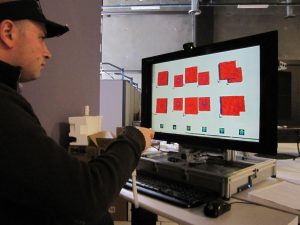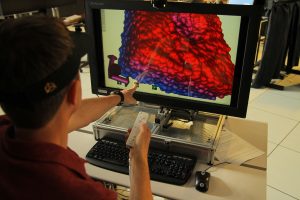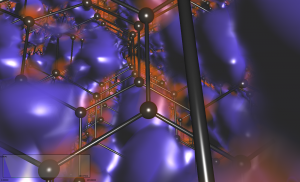Working closely with materials scientists, we are developing novel solutions to the analysis and visualization of nanoscale material structures. A custom volumetric framework for registration, analysis and visualization is being written. Because these structures are volumetric, another component of our research is to develop novel environments and interfaces for interacting with them. We are experimenting with autostereoscopic display systems for this purpose.
Display Hardware
We have integrated our software with Dynallax, an automated head-tracking stereoscopic display developed by Tom Peterka at the Argonne National Laboratory Mathematics and Computer Science (MCS) division. Stereo workstations could prove useful in a variety of interactive materials modeling tasks. In particular, we are interested in applying stereo environments to comparative visualization of surface features, and modeling initial geometry prior to DFT computation such as our CO binding energetics study above.
Our goal in developing Dynallax is to impact science exploration with a new work environment that is meaningful, accessible, and accurate. Because it is immersive, the scientist can focus on the problem instead of the technology. Having a desktop solution means that it is always available, with no added effort. The virtual world is portrayed accurately, in 3D, with true scale and color, high resolution, and maps directly to the real world, in our case, to materials science.
Display Software
For our display the software driving the device is run from a machine connected to it locally. It acts as a server that users can connect to with applications developed using our DVC SDK. These client applications then send stereo pairs to the server which are then interlaced and rendered to the device. In addition, the server responds to the client app with control data from the various input options available in the Dynallax Workstation.
The autostereoscopic affect is achieved through dynamic parallax barrier technology. In this method we direct right and left eye images interlaced on the back LCD to the viewers eyes through the barrier that is rendered on the front LCD.
Application Software
While many domain-specific applications exist for visualizing ball-and-stick models, our users are interested in volumetric models (e.g. charge density, potential) of material interfaces. To this end we have developed nanovol, an in-house interactive rendering tool, for display and analysis of materials models using both ball-and-stick and volume rendering modalities.




